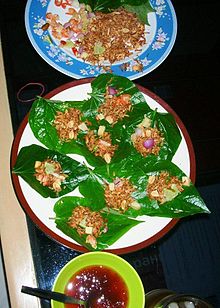|
Miang kham
Miang kham (Thai: เมี่ยงคำ, Lao: ໝ້ຽງຄຳ, RTGS: miang kham, pronounced [mîa̯ŋ kʰām]) is a traditional Southeast Asian snack from Thailand and Laos. It was introduced to the Siamese court of King Rama V by Princess Dara Rasmi.[1] In Laos, most people call it miang. The name miang kham translates to 'one bite wrap', from miang ('food wrapped in leaves') and kham ('a bite').  IngredientsMiang kham mostly consists of raw fresh leaves of lolot pepper (Thai: ชะพลู, RTGS: chaphlu) or purple coraltree (Thai: ทองหลาง, RTGS: thonglang)[2] that are filled with roasted coconut shavings and the following main ingredients chopped or cut into small pieces:
Background informationMiang kham is a snack food that originated in the Lao regions of Thailand, originally using pickled tea leaves (called miang in the northern Thai language).[1][3] The dish is mentioned in Epic of the Verse of foods, a book written by King Rama II.[4] In Thailand, Miang kham is usually eaten with family and friends. It is also popular in the Central Region of Thailand. This dish is mostly eaten during the raining season for it is then that cha phlu leaves are abundantly available, as it grows new leaves and shoots. Before wrapping the filled leaves are topped with palm syrup or sugar cane syrup which often has been cooked with lemongrass, galangal, ginger and fish sauce.[5]
Variants  In Laos, Miang kham is called Miang. Although a variety of Miang exists throughout the country, there are two popular main types: Miang Lao (or Miang Padaek) and Miang Luang Prabang (or Miang khao). Miang Lao uses dipping sauces made with fermented fish sauce (Padaek), or pieces of the fermented fish, which provides an intense flavor. There are a selection of vegetables, herbs and spices, and types of leaves used for wrapping, including lolot leaves, Chinese kale, lettuce, cabbage, spinach and perilla leaves. In some regions, Miang is often folded in cooked cabbage leaves (Lao: ກະລໍ່າປີ kaalampii). Miang Luang Prabang uses sticky rice paste in the place of dipping sauces. The paste is prepared by blending sticky rice puffs using a food processor and rehydrating the rice with a flavoring broth. The rice paste is spooned and wrapped together with vegetables, herbs and spices in a lolot leaf or lettuce, and served. Alternatively, for simplicity some people choose to pre-mix some of the herbs and spices with the rice paste during the blending process. This Lao snack is sold during festivals, in markets and on roadsides in Laos.[6] Miang can be tailored into a meal, for instance, by including grilled fish meat and Lao rice vermicelli (sen Khao poon) among the ingredients. A variation called miang pla includes pieces of deep-fried fish in addition to the standard ingredients.
Miang Kham Bua Lhuang (Thai: เมี่ยงคำบัวหลวง) is a snack dish originated in Thai royal cuisine in the central part of Thailand. Miang Kham Bua Lhuang (lotus petals wrapped bite-size appetizer) is usually eaten with family and friends. This dish is mostly eaten as appetizer or snack during the meals. The name "Miang Kham" means "one bite-size wrap". Form Miang (snack wrapped in lolot leaves) and Kham (one bite) in Thailand (Miang Kham, 2018.). Normally, this dish can have many types of wrap such as lolot leaves (Thai: ใบชะพลู) and pickled tea leaves (Thai: ใบเมี่ยง) which are originated in the north of Thailand. IngredientsWhen talking about "lotus" most people might think of lotus as offering to monks and Buddha. Actually, lotus petals can be eaten with many nutritional benefits e.g. high fiber for detoxifying and nourishing health. Also it can be cooked in good side dishes such as Ingredients of Miang Kham Bua Lhuang (Miang Kham Bua Lhuang, 2012),[7] with other ingredient e.g. shallots, chili peppers, gingers, garlic, limes, coconut sugar (Miang Kham Bua Lhuang Thai traditional snack food for good health, 2012).[8] References
External linksWikimedia Commons has media related to Miang kham. |
||||||||||||||||




